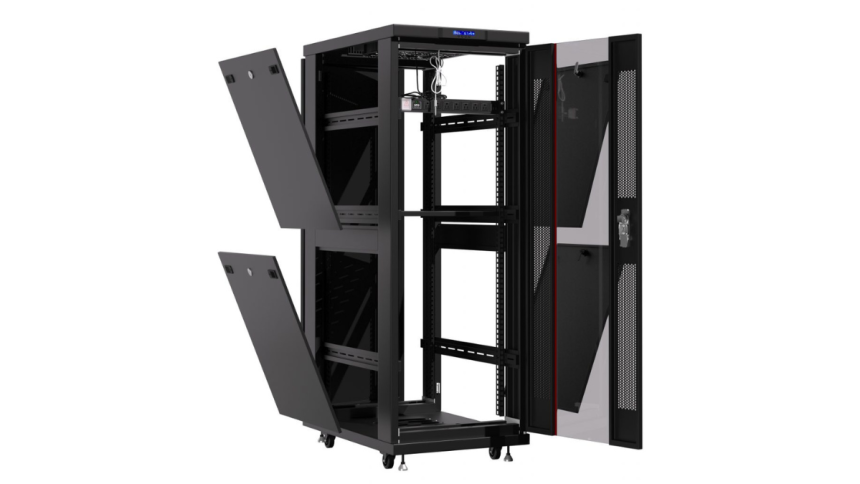Server racks are a crucial component of the infrastructure in any data center, IT department, or even small offices and retail stores that utilize a computer network. These devices serve multiple purposes. First, they allow for maximum space efficiency by organizing the placement of not only the equipment but also the cables. Second, they ensure optimal operating conditions for the equipment by regulating temperature and providing necessary ventilation. Third, they protect the equipment against unauthorized access and prevent potential damage or falls. Typically, servers, switches, power supplies, modems, routers, and patch panels are installed in these racks. In this article, we will discuss the key factors to consider when selecting a server rack.
Open or Closed Design?
There is not always a need to choose a closed server rack. In some cases, it’s worth considering open-frame designs. An open server rack consists of a metal frame with rails for mounting equipment. The advantages of an open server rack over a closed one include natural ventilation for the equipment, easy and quick access from all sides, no restrictions for cable management, and a lower cost. However, an open rack is only suitable for small, secure server rooms that are accessible only to IT specialists. If you plan to place the rack in areas with high foot traffic, it’s better to choose a closed design.
Floor-mounted or wall-mounted rack?
It’s important to decide where you want to place the rack — on the floor or the wall. Wall-mounted racks save space and can be placed under ceilings or on staircases. Sometimes, they have removable panels for easier equipment maintenance. However, wall-mounted racks are not designed for high loads or a large amount of equipment, and they are typically used for small network setups. Floor server racks are sturdier and more spacious, making them the preferred choice for dedicated server rooms.
Installable width in inches
The standard width of most server racks is 19 inches. There are also designs for smaller setups with a width of around 10 inches, as well as for larger servers with a width of 21 inches, although this is quite rare.
Height
The height of server racks is measured in U (units). 1U equals 1.75 inches, or 44.45 mm. Most devices installed inside have a height ranging from 1U to 4U, so by knowing the total number of U units required for your network equipment, you can determine the necessary height. However, it’s important to note that U units refer to the internal height of the rack, not the external dimensions of the cabinet or frame. The most common option is server cabinets with a height of 42U.
The external height, or the so-called overall height, is closely related to the rack’s design and may vary for the same nominal height due to additional equipment such as cooling fans on the top or wheels for mobility.
Width and depth
There are no official standards for these parameters, but for convenience, there are certain sizes that almost all manufacturers produce. The standard widths are 600 mm and 800 mm. The 600 mm width is the most common, while the 800 mm is the extended version. In 800 mm wide racks, it is easier to manage large bundles of cables, and the extra width can be used to install cable management systems inside the rack.
There are three standard depths — 1000 mm, 1070 mm, and 1200 mm. It is important to note that the external depth does not directly indicate how deep a device can be installed. Different racks vary in design and offer different amounts of space inside. Many of them feature a modular design, meaning the rack rails inside can be positioned in different ways. However, some space must be left at the back and front of each device to ensure proper cable management and airflow.
The installation depth varies for each rack, and this information is usually provided in its specifications. It indicates the positioning of the server rack rails, which simplifies the installation of the shelves included in the package. Typically, the design allows for 100 mm of space at the front and back for cable management.
Ventilation and cooling
Maintaining the optimal temperature inside a server rack is crucial for the proper functioning of the equipment. When selecting a closed server rack, it’s important to pay attention to ventilation holes, the ability to install fans, and compatibility with external cooling systems. For racks with high-density equipment placement, the installation of air conditioners or other specialized cooling systems may be necessary to prevent overheating.
Power supply
The server rack must provide safe and distributed power to all devices. The main component responsible for this is the PDU (Power Distribution Unit). There are the following types of PDUs to consider when choosing a server rack:
- Basic. Simple power distribution. Used in small racks, without a remote control.
- With load measurement. Displays the power consumption. Used when tracking energy usage is important.
- With management. Remote power on/off control for ports. Recommended for data centers and critical systems.
Calculation of Size and Load
We have gathered some recommendations that will help you independently calculate the required size of the server rack:
- Height (Units, U). To calculate the height, sum the number of units for all devices and add 20–30% for reserve. For example, if the server occupies 2U, the switch occupies 1U, and the UPS occupies 3U, the total height will be 8U. With reserve for additional devices and cables, it is recommended to choose a rack with a minimum height of 12U.
- Depth (mm). The depth of the rack should be greater than the depth of the largest device by 150–200 mm for ease of installation and ventilation. For example, if the server has a depth of 700 mm, a rack with a depth of 900 mm will be needed for easier installation. It is recommended to add at least 200 mm to the device’s depth.
- Width (mm). The standard width of the rack is 600 mm, but for better cable management, it is better to choose 800 mm.
- Total Load (kg). The total weight of the equipment should not exceed 50–60% of the maximum allowable load of the rack. For example, if the total weight of the equipment is around 60 kg, choose a rack with a maximum load capacity of 150 kg to ensure a weight reserve and avoid overloading.
- Load per Shelf (kg). Consider the weight of individual heavy devices placed on the shelves. For example, if the UPS weighs 25 kg, the shelf should support at least 40 kg. Always check the shelf specifications separately to ensure they can handle the required load.
Conclusion
Choosing the right server rack is a crucial step in ensuring the efficiency, safety, and longevity of your equipment. By considering key factors such as height, depth, width, and load capacity, you can make an informed decision that best suits your needs. Also, consider where to place the server rack. This is important for selecting the right rack and ensuring the safety of your equipment.
Lynn Martelli is an editor at Readability. She received her MFA in Creative Writing from Antioch University and has worked as an editor for over 10 years. Lynn has edited a wide variety of books, including fiction, non-fiction, memoirs, and more. In her free time, Lynn enjoys reading, writing, and spending time with her family and friends.















